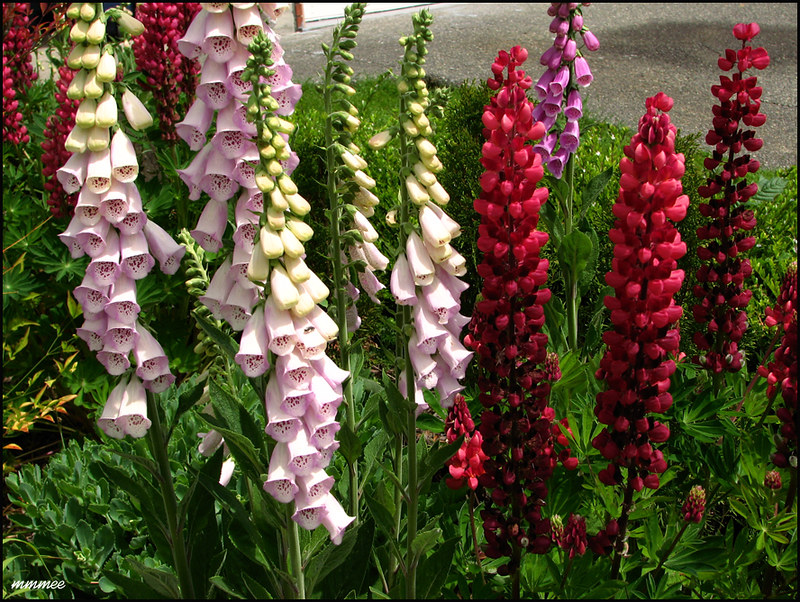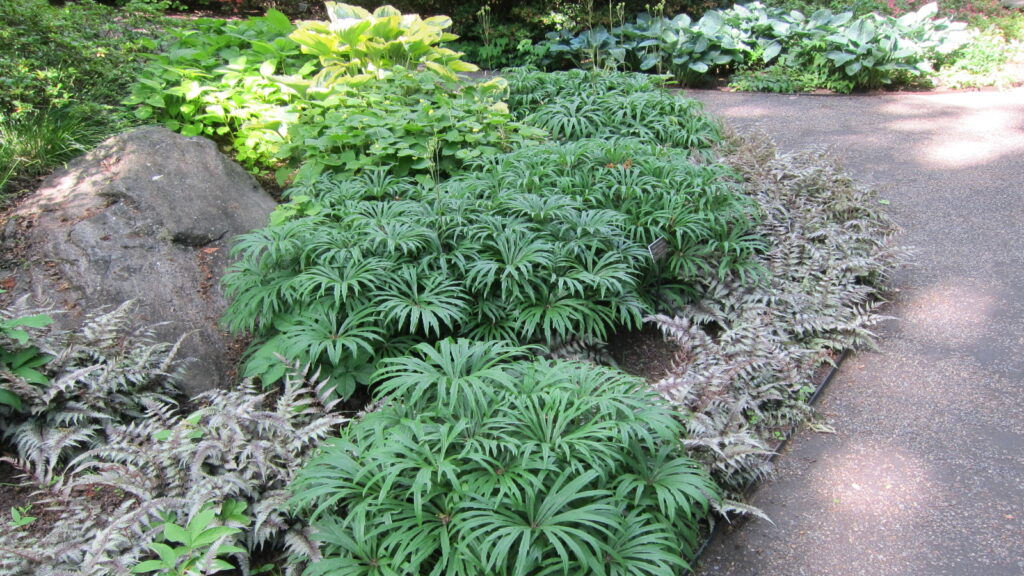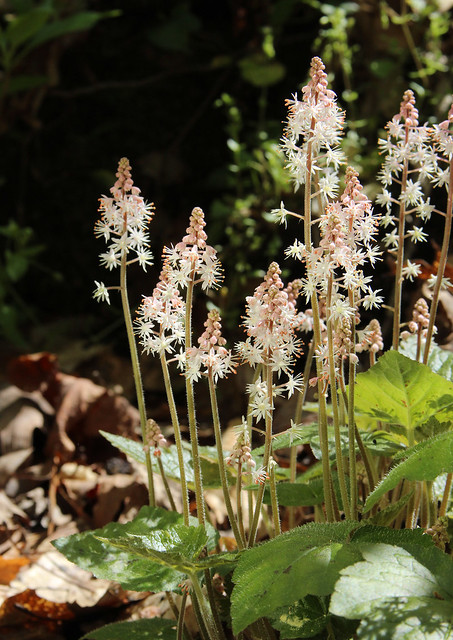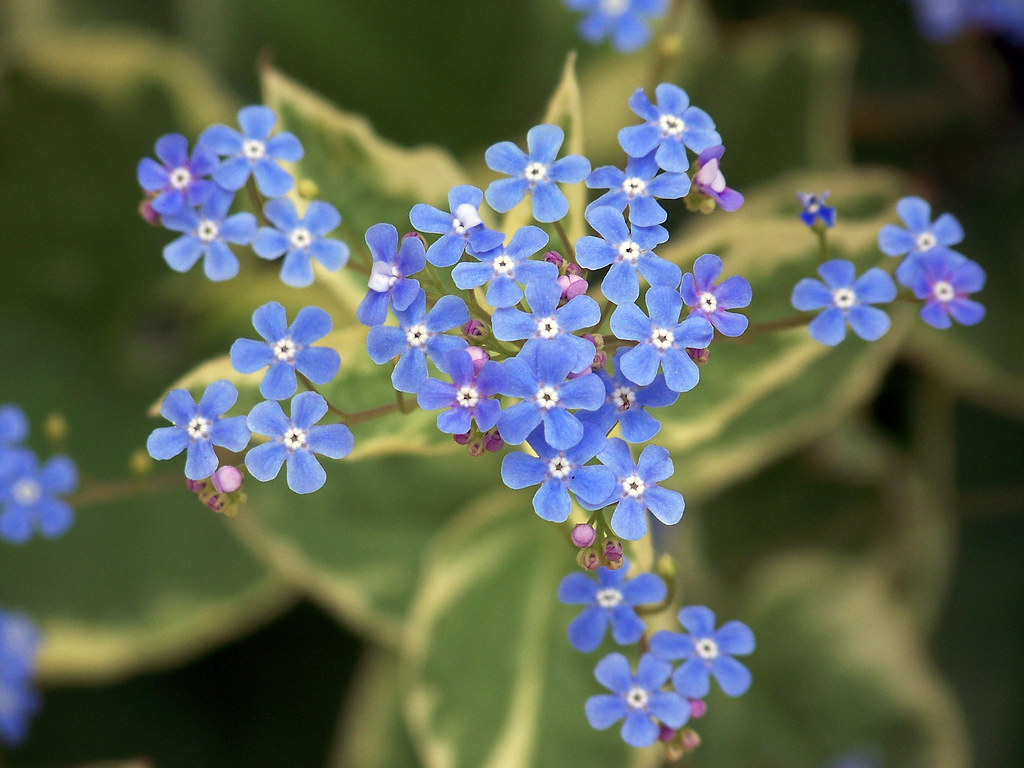If you’re anything like me, you know the pain of watching deer munch through your carefully planted garden like it’s an all-you-can-eat buffet.
Trying to grow plants in shady spots is already a challenge, and when you add hungry deer to the mix, it can feel downright impossible.
But what about those of us dealing with both shade and deer problems – is there any hope for a nice garden?
Read on…spoiler alert: YOU DON’T HAVE TO GIVE UP ON YOUR GARDEN DREAMS!
Foxgloves (Digitalis)
Foxgloves are towering biennial plants that offer pink, purple, or white tubular flowers on tall spikes during early-to-mid summer. The first year they produce a rosette of fuzzy green leaves, followed by dramatic 3-5 foot flower stalks in year two.
They’re surprisingly hardy in zones 4-9 and perform well in partial to full shade. Though short-lived, foxgloves self-seed readily if flower heads are left in place. Popular varieties include the pure white ‘Alba,’ speckled pink ‘Excelsior,’ and compact ‘Foxy.’
These garden classics need well-draining soil but can handle dry conditions once established. All parts are toxic, which helps explain their strong deer resistance.
False Goat’s Beard (Astilbes)
Look for these shade-loving perennials in zones 4-8, where they bring reliable color to otherwise dim areas. The showy plumes appear in summer, rising 18-24 inches above mounds of glossy, fern-like leaves.
Colors range from bright pink to deep red and pure white, depending on the variety. While they prefer moist, well-drained soil, astilbes can handle dry conditions once established.
The flowers dry beautifully and last for months, making them perfect for winter arrangements. Deer and rabbits leave them alone, and they’re particularly heat-hardy in northern gardens. Try ‘Fanal’ for deep red blooms, ‘Deutschland’ for crisp white, or ‘Rheinland’ for clear pink flowers.
Bleeding Hearts (Dicentra)
Bleeding hearts feature distinctive heart-shaped pink and white flowers that dangle gracefully from arching stems. This hardy perennial thrives in zones 3-9 and reliably blooms in spring and early summer, sometimes reblooming in fall in cooler regions.
The blue-green, finely cut foliage reaches 2-3 feet tall and stays attractive after flowering. Common varieties include ‘Gold Heart’ with bright yellow leaves, ‘Valentine’ with deep red flowers, and ‘Alba’ with pure white blooms. Plants prefer rich, moist soil and partial to full shade.
Though they go dormant in hot summers, bleeding hearts bounce back each spring. Deer and rabbits typically leave them alone.
Japanese Painted Ferns (Athyrium niponicum)
Looking for drama in a shade garden? Japanese painted ferns add a silvery splash to dark corners with their metallic-gray fronds and burgundy highlights. These perennial ferns grow between 12-18 inches tall and thrive in zones 4-8.
Popular varieties include ‘Ghost’, sporting frosted silver leaves, ‘Burgundy Lace’ with deep purple stems, and ‘Silver Falls’ featuring arching gray-green fronds. They prefer rich, well-drained soil and consistent moisture.
While these ferns don’t flower, their unique foliage maintains interest from spring through fall. They’re particularly heat tolerant for a fern and naturally resist deer browsing. Plant in partial to full shade for best color development.
Lungwort (Pulmonaria)
Lungwort earns a top spot among shade gardens with its white-spotted leaves that seem to glow in shady spots. This hardy perennial (zones 4-8) features clusters of pink buds that open to blue flowers in early spring, creating a two-toned display.
The fuzzy, speckled foliage stays looking good through summer and fall, even in dry conditions. Plant lungwort in partial to full shade and provide well-draining soil with regular moisture.
Popular varieties include ‘Sissinghurst White’ with pure white blooms, ‘Mrs. Moon’ showing bright pink-to-blue flowers, and ‘Raspberry Splash’ sporting rich raspberry-pink blossoms. Deer and rabbits typically avoid this low-maintenance plant.
Foamflower (Tiarella)
Foamflower earns its name from the masses of tiny white or pink flowers that rise like foam above the leaves in mid to late spring. This hardy perennial, native to North America, grows best in zones 4-8 and forms neat clumps of maple-shaped leaves.
The foliage adds interest year-round, ranging from green to burgundy depending on the variety. Most foamflowers prefer partial to full shade and need consistently moist soil, though they can handle brief dry spells once established.
Popular varieties include ‘Pink Skyrocket’ with its rosy blooms, ‘Eco Rambling Talisman’ featuring dark-veined leaves, and ‘Elizabeth Oliver’ showing off double pink flowers. Deer and rabbits tend to ignore these low-maintenance plants.
Fumitory (Corydalis)
This pretty woodland perennial brings soft clouds of blue, pink, purple, or white blooms from spring through fall. The fern-like, blue-green foliage stays attractive all season and makes a nice backdrop for the dainty, spurred flowers.
Hardy in zones 5-8, Corydalis happily grows in shady spots and needs consistent moisture to thrive. Blue Corydalis can go dormant in hot summers while yellow Corydalis blooms longer into the season.
Notable varieties include ‘Blue Panda’ with violet-blue flowers, ‘Canary Feathers’ with yellow blooms, and ‘Berry Exciting’ featuring pink blossoms. Deer and rabbits leave this plant alone, though slugs may nibble the leaves.
Caucasian Forget-me-not (Brunnera)
Brunnera makes a perfect companion for hostas and other deer-resistant shade plants. Growing 12-18 inches tall, this hardy perennial features fuzzy, heart-shaped leaves that create lush ground cover.
In early spring, clouds of tiny blue flowers float above the foliage, looking like forget-me-nots. The silvery-green leaves maintain interest all season long. Several varieties offer different leaf patterns – ‘Jack Frost’ has silver leaves with green veins, while ‘Sea Heart’ sports extra-wide silver leaves.
‘Alexander’s Great’ grows especially large. Grows best in rich, well-drained soil and part to full shade. Tolerates drought once established. Hardy in zones 3-8.
Barrenwort (Epimedium)
Barrenwort delivers reliable spring color in the shadiest parts of your garden. This perennial (zones 4-8) features heart-shaped leaves that start out reddish in spring, mature to green, and often take on burgundy tints in fall.
Small, spurred flowers bloom in April-May, dangling like tiny jewelry in shades of yellow, pink, white, or purple. Popular varieties include ‘Lilafee’ with lavender blooms, ‘Niveum’ featuring pure white flowers, and ‘Sulphureum’ with soft yellow blossoms.
Barrenwort handles dry shade like a champ once established and stays evergreen in mild climates. Deer and rabbits typically pass it by, making it perfect for woodland gardens.
Lenten Rose (Hellebores)
Winter-blooming hellebores prove that even the coldest months can have flowers. These perennials grow best in partial to full shade and are hardy in zones 4-9. The leathery, evergreen foliage retains its deep green color throughout the year, while nodding flowers appear from late winter through early spring.
Popular varieties include Lenten Rose with pink and purple blooms, Christmas Rose featuring pure white flowers, and Royal Heritage with colors ranging from deep burgundy to cream.
Hellebores handle drought once established and prefer well-drained soil with consistent moisture. All parts of the plant are poisonous, making them naturally resistant to deer, rabbits, and other garden pests.











